Giraffes slip silently on to the vulnerable list
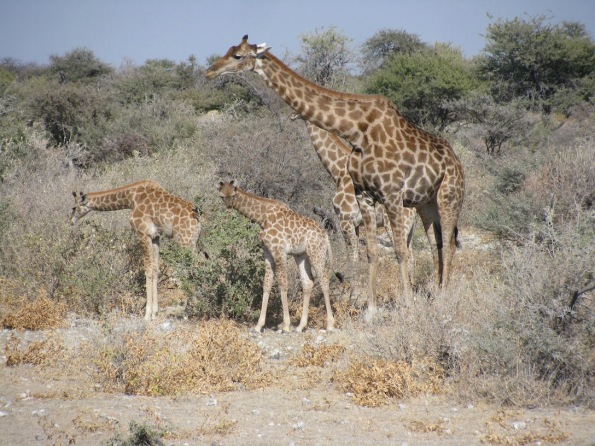
A sad and disturbing article appeared on one of my news feeds the other day. It’s not new news. In fact, the article was from the December 2015 Smithsonian magazine, but the problem it describes isn’t going away.
According to the latest ‘red list’ compiled by the International Union for the Conservation of Nature, the giraffe—the world’s tallest animal—is at risk of extinction after suffering a devastating decline in numbers over the last 30 years. Numbers have plummeted from 157,000 individuals in 1985 to 97,500 at last count, and the giraffe is now listed as vulnerable.
Giraffes face two main threats, cities and towns encroaching on their habitat and poaching. Poaching has become increasingly problematic. Hungry villagers sometimes kill the animals for food, and there are reports that many giraffes are slaughtered for just their tails. They are considered status symbols in some cultures and have been used as bracelets, fly whisks and even as a dowry when asking a bride’s father for his daughter’s hand in marriage.

The biggest problem for giraffes, though, may be the lack of attention over the years. ‘I am absolutely amazed that no one has a clue’ about the dwindling numbers, said Julian Fennessy, executive director of Giraffe Conservation Foundation. It’s a silent extinction with some populations numbering less than 400. ‘That is more endangered than any gorilla, or almost any large mammal in the world.’
Duke University conservation biologist Stuart Pimm said ‘There’s a strong tendency to think that familiar species (such as giraffes, chimps, etc.) must be OK because they are familiar and we see them in zoos.’ In fact over the last century, giraffes have silently been going extinct across Africa. They have already disappeared from seven countries—Burkina Faso, Eritrea, Guinea, Malawi, Mauritania, Nigeria and Senegal.
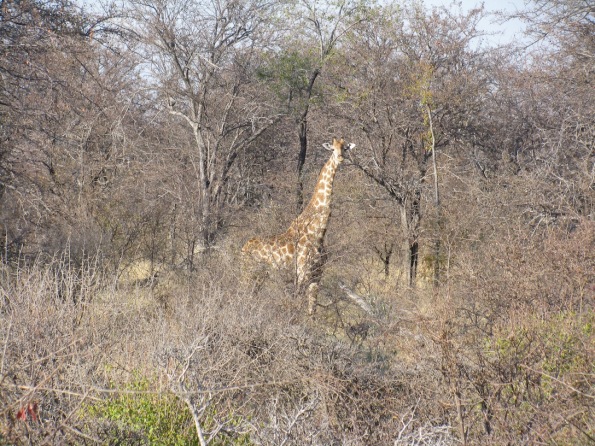
The first giraffe I saw in the wild
So why am I especially concerned about giraffes? Because they were some of the first big animals I saw in the wild during our overland truck trip in Africa. The first encounter was in Etosha national park in northwest Namibia.
We arrived at the park in the afternoon and set up camp. We were old hands at this by now, so it wasn’t long before Chris, our driver, hustled everyone into the truck so we could go exploring. We saw Thomson’s gazelles first and then came the giraffes. Individuals and small groups, adults and juveniles, then larger groups. The collective noun for a group of giraffes is rather obvious—a tower.
I have more than 40 pics from that day that include giraffes—in the bush, nuzzling offspring, grazing, waiting for a turn at the watering hole, drinking, canoodling?
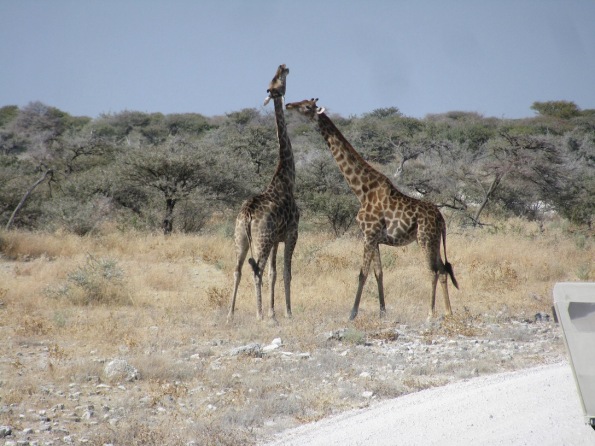
Giraffes—some details
They are magnificent creatures so here’s a bit more about them.
As I already mentioned, giraffes are the world tallest animals. Males grow up to 18 feet tall with females reaching 14 feet, (or 5.5 and 4.3 metres, respectively). Males weigh up to 3000 pounds (1360 kilograms) and females are about half that.
Their body parts are big too. The tongue is purple and about 21 inches (55 centimetres) long. The neck and legs are 6 feet long (and to think I call myself leggypeggy!) The measurement that really struck me was their lung capacity. Their lungs can hold 12 gallons (55 litres) of air—nine times more than human lungs.
This was another surprise. According to PBS Nature, giraffes sleep about 20 minutes or less per day. Staying awake allows them to be constantly on alert for predators. They usually get their sleep in quick power naps that last just a couple of minutes. I wouldn’t mind perfecting that.
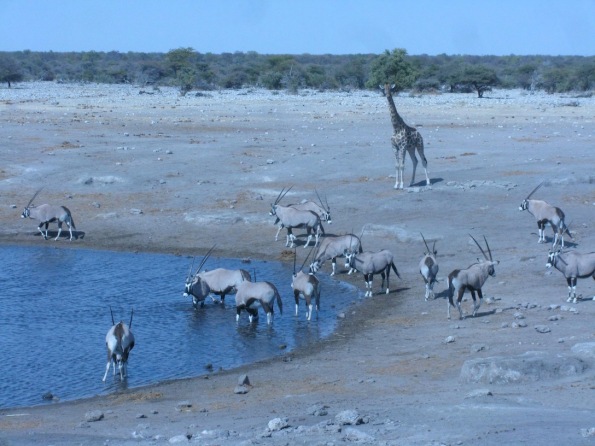
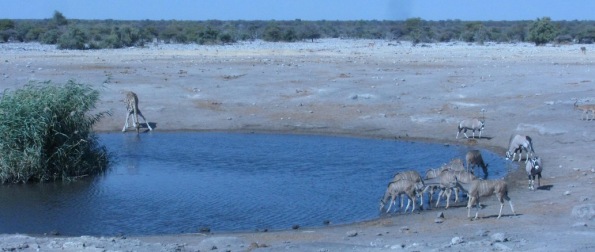
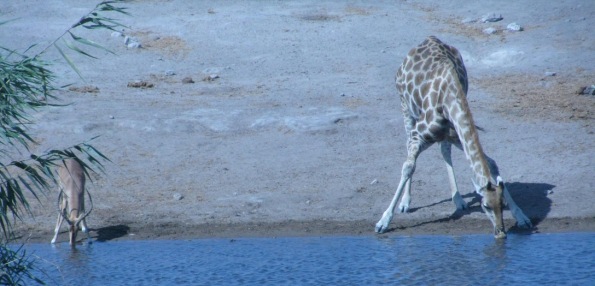
Giraffes are herbivores, which means they eat only plants. Their long necks allow them to reach leaves, seeds, fruits, buds and branches high up in mimosa and acacia trees. They can eat hundreds of pounds of leaves per week, but can go without drinking for weeks at a time because of the moisture in the vegetation they eat.
Just like our fingerprints and a zebra’s stripes, a giraffe’s coat pattern is unique to each animal. The pattern and the small hump on a giraffe’s back are similar to those of a leopard. Years ago, people thought the giraffe was a combination of a camel and a leopard, and called them ‘camel-leopards’.
And some final comments. I haven’t added captions to most of the pics here. They were all taken on the same day in Etosha national park. I’ll do more posts about Etosha, but I wanted to share the situation giraffes face in a post of its own.

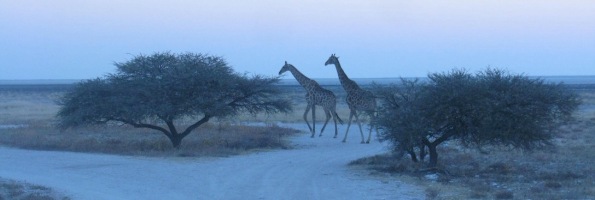

Beautiful creatures and you get to see them out in the world. I envy you! Thanks for bringing the world to Nebraska.
LikeLiked by 3 people
You are most welcome. It’s a great way for me to relive our travels.
LikeLiked by 2 people
So love these beautiful animals! Thank you for sharing♥️
LikeLiked by 3 people
So glad you enjoyed it.
LikeLiked by 3 people
Wonderful post – sad to learn these magnificent creatures are so seriously endangered.
LikeLiked by 5 people
I hope spreading the word helps to galvanise people into action.
LikeLiked by 5 people
I recall being overwhelmed when I went to Kenya, and saw a huge group of giraffes in the wild. Having only ever seen a few together in London Zoo, I hadn’t realised how many were to be found in such large herds. That was in 1983, and to think they are being killed just for their tails is simply awful.
You are right to highlight this sad news, Peggy, even if it is a couple of years old.
Best wishes, Pete.
LikeLiked by 3 people
The original report may have come from December 2015, but I checked the ‘red list’ today and the giraffes are still on it as vulnerable.
LikeLiked by 3 people
Sad indeed. Killing for meat because you are hungry is one thing, but tails as fly-swats and emblems is just too much.
LikeLiked by 5 people
Absolutely deplorable.
LikeLiked by 3 people
That is really sad to know that the numbers have decreased so distinctly 😓 I hope they survive so our future generations can notice them too. Else it would be such a shame. Great post👍
LikeLiked by 2 people
Thanks for stopping by and for commenting. It would be a terrible shame to lose giraffes.
LikeLiked by 3 people
I agree…
LikeLiked by 2 people
This post has it all. Interesting message, personal anecdote, and trivia. One of my favourite bloggers. 🙏
LikeLiked by 4 people
Aw thanks so much.
LikeLiked by 2 people
Reblogged this on Sascha Darlington's Microcosm Explored and commented:
Excellent post from Peggy. But sad to know we could lose these marvelous creatures.
LikeLiked by 4 people
I really appreciate the reblog. Thanks heaps. Let’s hope spreading the word can bring about more action.
LikeLiked by 3 people
You’re welcome. I don’t know how this info slipped by me originally. I’m usually pretty up on wildlife and environmental things. Very sad. Your pictures are wonderful as is your story. They look like great creatures in the wild.
LikeLiked by 3 people
It is so wonderful to see them in the wild, when they take absolutely no notice of you or gaze intently to see who/what you are.
LikeLiked by 2 people
I didn’t know they were endangered. There was so many of them in Kenya. They are beautiful.
LikeLiked by 3 people
Luckily they aren’t considered endangered yet—their status is listed as vulnerable—but that could worsen at any time.
LikeLiked by 2 people
A wonderful yet sad post, one we need to read and take note of. What have we done? (or rather not done?)
LikeLiked by 2 people
I read that the country of Niger has done a lot to help their giraffe population recover, so with effort there can be positive change.
LikeLiked by 3 people
Hope, there’s always a spark as you say.
LikeLiked by 2 people
I love giraffes, they are such wonderful creatures. I find it so sad that they’re (and the other animals that are) are on this list. xxx
LikeLiked by 4 people
It’s is heartbreaking. Here’s hoping more action to save them is taken.
LikeLiked by 4 people
There are three in my backyard.
LikeLiked by 3 people
Can I visit?
LikeLiked by 1 person
I have relocated from Darwin to South Perth and Perth Zoo is a few minutes walk from my apartment. They just delivered a baby giraffe a couple of weeks ago.
LikeLiked by 2 people
Lucky you. What wonderful neighbours.
LikeLiked by 1 person
I remember seeing these gorgeous creatures at a safari park a couple of years ago and marvelling at them. I also caught two ‘canoodling’ too! Such sad news and awful to think they are in such danger. They deserve far more than that, they are beautiful. A wonderful post xx
LikeLiked by 2 people
Thanks so much. I’m glad someone else has caught them canoodling!
LikeLiked by 2 people
This is a sad, amazing tale, Peg. Glad you got to travel there to see these and other beautiful animals, and, that you brought this devastating news to our attention. I had no idea, and frankly, can’t imagine the world with giraffes. How is it that man can be so thoughtless, greedy, and cruel?
Mary
LikeLiked by 2 people
Mary, I don’t think any of us can imagine a world without giraffes. Let’s hope some plans of action can be adopted.
LikeLiked by 2 people
As you said, Peggy, I think we all just take it for granted that because we tend to see certain animals all the time, like elephants, lions, and even gorillas, that we feel they’re doing all right and are not on the verge of extinction. It was alarming to me to recently hear how the polar bear population is dwindling due to melting ice, loss of food supply, and poaching. Giraffes are so beautiful to look at and it would be a shame to lose these majestic looking creatures. Love the pictures here. :O)
LikeLiked by 3 people
Thanks so much. I think the polar bear’s plight is even worse because they aren’t being poached. They are the victims of the climate change that so many in power deny.
LikeLiked by 1 person
Yes, you’re right, peggy, and that denial makes it all that much sadder.
LikeLiked by 2 people
Precisely.
LikeLiked by 1 person
My goodness! Thanks for the heads up. Oddly (co-incidentally) I did an A-Z challenge post which talked about giraffes in part. My “H” (for Hogle Zoo) piece talked about why the zoo doesn’t have giraffes any more…a lot of shocking mistreatment for those animals (not on purpose, but they are so large that housing them adequately is a problem. To our zoo’s credit, we had one of the longest lived giraffe housed there. They are magnificent and I’m sorry to hear they are on the decline. But we WILL treat Mother Earth as if it’s our sole province and we don’t have to share nor consider the other creatures on her. 😦
LikeLiked by 2 people
Yes, giraffes are very hard to care for in captivity. It is definitely to your zoo’s credit to have one live so long. Now if we could just get everyone else to show Mother Earth and her non-human creatures such respect.
LikeLiked by 2 people
My husband told me about this situation with the giraffes not too long ago, and we were both shocked and curious as to why they don’t receive as much press as the other endangered animals. Thanks for sharing this.
LikeLiked by 2 people
Giraffes are so familiar to us in zoos, children’s books and such, that we tend to assume everything is fine. Here’s hoping people wake up to the fact that they aren’t as fine as we might think.
LikeLiked by 2 people
Loved all the pictures. Nature sets people free! 🙂
LikeLiked by 2 people
Thanks for stopping by and for commenting.
LikeLiked by 2 people
This is so devastating; thank you for sharing. Giraffes are some of the ‘staple’ animals you expect to see at a zoo and associate with Africa. It’s so horrible to think that we may be driving yet another animal to extinction.
LikeLiked by 2 people
I think it’s because they are such ‘staples’ in our experiences that we tend to think everything is fine with them. Here’s hoping more countries take action.
LikeLiked by 2 people
Here’s hoping!
LikeLiked by 2 people
Great post Peggy, this caught my attention because I have just returned from a trip in Uganda where we got to see the biggest herd of Giraffes in the World. It was a magical experience. Very sad that these magnificent creatures are one the endangered animals list.
LikeLiked by 2 people
Luckily they aren’t yet considered endangered—their status is vulnerable—but it will take widespread action to keep their numbers from falling further.
LikeLiked by 3 people
Hopefully if the African continent can stop or reduce their fighting it would help, as I think the giraffes have probably gone to feed their troops. Droughts and people starving is another reason for their decline. it is a hard life for the people of africa too. I think they should put people on the endangered list. I do love giraffes too though.
LikeLiked by 2 people
You’re right Dorothy. People in Africa are doing it tough too, and the fighting and unrest on the continent harm everyone’s (human and non-human) struggle to survive.
LikeLiked by 1 person
The big decline of numbers is indeed worrying. If it keeps up at that rate they’ll rapidly go from vulnerable to endangered in the blink of an eye. I had no idea. I can understand the slaughter for the hungry, but for fly swats…. I guess there’s just a lot of ignorance out there.
LikeLiked by 1 person
Ignorance and greed. 😦
LikeLike
Thank you Peggy. They are truly magnificent animals. I wonder if there is any preservation being undertaken. Your photos, as always, are superb especially the ones around the waterhole at what looks like late afternoon or dusk. Thanks again.
LikeLiked by 1 person
You have a good eye, Louise. It was late afternoon and then dusk (as well as a slightly funny setting on my camera!).
LikeLike
I tend to be an optimist, Peggy. But the world makes it difficult, and Africa even more so. Like you, I have ancient memories of these gorgeous animals running free across the plains. For me, it was in the Serenghetti and I had left the road to drive out among these gentle giants. There is so much that needs saving in this world. And it can all be saved. If only… –Curt
LikeLiked by 1 person
If only we make the effort. Niger has brought their giraffe population back from the brink. It can be done.
LikeLike
Wolves are making a comeback in the Western US, Peggy. Yes, it can be done. –Curt
LikeLiked by 2 people
I’ve seen a wonderful video clip about the return of the wolves. I could watch it on a continuous loop.
LikeLike
Wonderful series of images and thanks for bringing the dwindling numbers to my attention. I certainly never thought of giraffes as being endangered or such an enormous reduction in their numbers.
I daresay there are many more animals in decline that we don’t know about due to lack of publicity.
LikeLiked by 1 person
Thanks Vicki. I’ll try to be on the lookout for other wildlife stories that need to be shared more widely. At least it’s something.
LikeLiked by 1 person
Thanks for sharing Peggy! They are such graceful animals in the wild. I saw them in Zimbabwe and Botswana many years ago. I saw the news article but you’ve done a great job in personalising it.
I don’t know! What can we do? No governments, organisations or collections of people seem to be able to do anything, or perhaps even want to, about everything we are losing in the world today. And we have so much to lose! Yet, dry economics and international posturing seem to clog up our news channels.
So called difficult problems such as world poverty, preserving biodiversity and habitat loss are soluble. But, there is no international commitment!
My friend Rukmini says to keep on signing petitions and protest on the streets, but where does one find the energy. Yet, we are becoming immune to lies, corruption and bad behaviour.
All the best!
LikeLiked by 1 person
Thanks Tony. Things are happening to protect giraffes. It can be done if people commit to the effort. Here’s an article about what’s happening in Niger. http://www.dw.com/en/high-hopes-for-giraffes-in-niger/a-38038753
LikeLiked by 1 person
I had no idea that giraffes were under threat. How wonderful that you had the chance to see them in the wild. This world makes me sad.
LikeLiked by 1 person
Sometimes the world makes me sad too. We all need to try harder.
LikeLiked by 1 person
We certainly do.
LikeLiked by 1 person
I didn’t know this either! They’ve slipped under the radar a bit. So many animals that we’ve pushed to the limits.
LikeLiked by 1 person
I was shocked when I saw the report, and to think this news has been available since 2015.
LikeLike
Jeffrey the Giraffe and all his relatives are magnificent…. what a shame to read that they are on the vulnerable list of possible extinction. The Bronx Zoo in NYC has quite a few and they are beautiful to watch. I always thought they sleep only two hours a night.. but now a correction from your comments, only a power sleep of 20 minutes.. isn’t that amazing! Further, a giraffe’s heart weigh about 25 pounds (huge) in order to pump blood to their brain.
LikeLiked by 1 person
Just think what we could accomplish if we could get by on 20 minutes of sleep a day. Rather frightening thought.
LikeLike
I wonder if giraffes would survive in the wild here in Australia. I suppose if camels and horses do perhaps the giraffes might. At least we would not be killing them for food or encroaching large cities.
LikeLiked by 1 person
Interesting thought Gerard. I wonder if there enough scrub out there for them to eat?
LikeLike
Good morning !! Excellent post!!!
In particular, the resolution cited the need for better security at parks and wildlife refuges.
LikeLiked by 1 person
Yes, better security at parks and wildlife refuges would be a vast improvement.
LikeLiked by 1 person
How sad. They are such beautiful animals.
LikeLiked by 1 person
Maybe the alarm bells will ring loud enough to bring about action.
LikeLike
I’m pleased you got to take all these lovely pictures. The need for food I can understand, but trophies – no way
LikeLiked by 1 person
Yep, trophies—no way.
LikeLiked by 1 person
I had no idea giraffes are in trouble. As you suggest, we kind of take it for granted they’re a common animal. It’s shocking, but on the other hand maybe not that surprising.
LikeLiked by 1 person
I thought it was important to share the information, so that people could think about how we might be able to do more to protect giraffes and many other species.
LikeLiked by 1 person
Sad to hear another species has been added to the list. Thanks for sharing
LikeLiked by 1 person
I’ll try to report other occurrences of species being added or—better still—removed from the list.
LikeLike
I hope there is more of the removal than addition, but…..
LikeLiked by 1 person
Wow, it’s amazing that giraffe’s only need 20 minutes of sleep a day. I didn’t realize that any animal could be along with so little.
LikeLiked by 2 people
It was a huge surprise to me too.
LikeLike
I have seen some articles recently about the threat to them, but as often happens it gets lost amongst all the animals disappearing or at risk of extinction. Like the poor white Rhino, that has only two females left of the species. So sad.
Great blog. Love the picts. I am hoping my daughter gets a chance to see a “tower” of giraffes.
LikeLiked by 1 person
Thanks so much. I, too, hope your daughter gets to see a tower of giraffes.
LikeLiked by 1 person
Regarding White/Black Rhinos,
I have a friend in Moscow who this past month 3/2018 went to the Circus in Soshi, which featured a Rhino and was part of the show. And we talked about Rhinos via e-mails. One person replied about
the Rhinos in Africa, See below FYI-
==========
Actually, I there are two subspecies of white rhino: the northern white rhino and the southern white rhino, as well as the black rhino. Sudan — the famous male northern white rhino that just died — was the last male survivor of his subspecies living anywhere. However, scientists are still hoping to use in vitro fertilization techniques with other subspecies to produce baby northern white rhinos from frozen embryos. However, a recent TV documentary on PBS said the process is very expensive — and the results are scientifically uncertain. I don’t believe the process has ever succeeded.
Sudan was one of several northern white rhinos taken to a breeding program in Czechoslovakia about 40 years ago, to try to help the subspecies survive. However, the rhinos did not thrive in that unnatural environment, so the survivors were eventually returned home. Only one of Sudan’s daughters and one of his granddaughters survive today; there are no other surviving northern white rhinos on the earth now.
Author withheld
===============
Sy S.
LikeLiked by 2 people
Hi Sy. Thanks for this extra detail.
LikeLike
They are indeed magnificent creatures Peggy, and creatures one would think will be around forever…. but not so. Awareness here is definitely the key, thanks for sharing this. 🙂
LikeLiked by 1 person
Thanks, I posted this in an effort to spread awareness.
LikeLiked by 2 people
👍🏼😊
LikeLiked by 1 person
How amazing it must have been to see them in the wild like that. And how sad that their numbers are dwindling so badly. I love your photos.
Alison
LikeLiked by 1 person
Oh thanks, Alison. It was a wonderful experience.
LikeLiked by 1 person
These photos are beautiful, but now have a touch of tragedy to them, too. You’re absolutely right that we forget the “common” animals we’re used to seeing are just as vulnerable to poaching as other creatures. I just didn’t know they could be killed for their tails. We usually think animals are killed for meat, or ivory, but I never thought of just their tails. Ugh, people can be foolish…
LikeLiked by 2 people
Thanks for adding a comment. We’re all guilty of thinking the common animals are okay. I guess we need to start thinking that nothing might be okay.
LikeLiked by 1 person
I get so upset by reports of the loss of genetic diversity and species extinction. I wish I could shake the world back to its senses. Poaching and unnecessary hunting is a big problem.
LikeLiked by 1 person
It would be so wonderful if we could shake the world back to its senses.
LikeLike
I suspect that many more species of wild animals than we know about are threatened all over the world, but giraffes strike a special place in my heart. Their size, appearance, and relative gentleness are iconic and remind us what’s good about protecting wildlife in their native habitats. No longer present in seven African nations – a tragedy. Thanks for an important article about giraffes.
LikeLiked by 1 person
It’s heartbreaking to think of the many species of wild animals that are threatened. I hoped that news of the giraffe’s plight would remind people of the importance of conservation.
LikeLiked by 1 person
We had a giraffe baby in captivity in Dallas. She was her own 24/7 video channel. She was romping around one day, lost her balance and slammed into a wall. Broke her neck. Broke her mom’s and a lot of people’s hearts. Kindred spirits in a different format. And now some lunatic thinks big game hunting should be okay. I think the day the giraffes and elephants and wild cats are armed as well as the hunters. You bet. Or hunt them bare handed on their turf. It’s all so ridiculous. when the balance goes, we all go.
LikeLiked by 2 people
You are so right, Phil, on every count. Arm the animals and disarm the hunters. What a tragedy at the zoo!
LikeLike
What a gorgeous and informative post!
LikeLiked by 1 person
Thanks so much.
LikeLiked by 1 person
I had no idea that the giraffe population was so precarious! Why must we destroy everything that is beautiful in the world?
LikeLiked by 1 person
You’re right. Most of us won’t win points for our good behaviour.
LikeLiked by 1 person
Heartbreaking to read this!
LikeLiked by 1 person
We just visited an animal reserve in Senegal. Their giraffe population is on the rise.
LikeLike